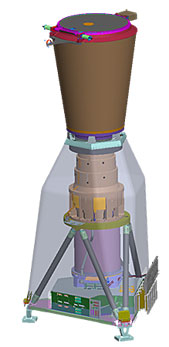 The Geostationary Lightning Mapper (GLM) for the GOES-R spacecraft will provide continuous measurement of lightning (in-cloud, cloud-to-cloud, and cloud-to-ground) in the Western hemisphere from a geostationary orbit. The system will collect lightning location and frequency data to aid the forecasting of storm intensity.
The Geostationary Lightning Mapper (GLM) for the GOES-R spacecraft will provide continuous measurement of lightning (in-cloud, cloud-to-cloud, and cloud-to-ground) in the Western hemisphere from a geostationary orbit. The system will collect lightning location and frequency data to aid the forecasting of storm intensity.
The driving thermal requirement for the GLM thermal design was to keep the flocal plane array (FPA) at 25oC ±2oC for any operating radiator temperature between -10oC and +12oC. To achieve this goal, the system uses parallel, temperature-controlled, loop heat pipes (LHPs) located between the FPA interface and a remote radiator. Thermal Desktop and FloCAD were used to simulate transient circulation of the two-phase working fluid within the two LHPs and predict the temperature distribution across the condenser plate. It was also used to validate the method of temperature control for the LHP. Thermal Desktop and FloCAD were selected for the following reasons:
- Simultaneously solve the flow momentum, energy, and mass conservation equations for the two-phase and single-phase fluid flow for each fluid lump and path separately as well as for the two fluid submodels.
- Model heat transfer between the fluid and the structure (fluid convection).
- Model system heat transfer: conductive (conduction in the condenser plate), and radiative (radiation between the environment to the LHP components).
- Model the phase change heat transfer (evaporation and condensation).
- FloCAD provides unique and proven tools for modeling LHPs.
- The ability to model LHP startup transients.
- The ability to assess load sharing between parallel LHPs.
- The ability to easily correlate a model to test results.
Download the publication for more information on this system
